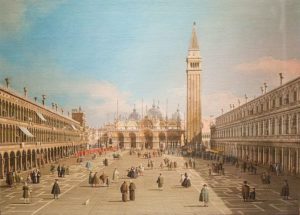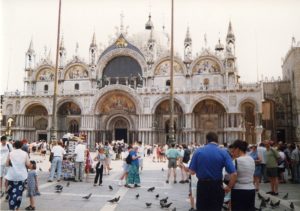Enda O’Doherty writes: In Watermark: An Essay on Venice (1992), the Russian poet Joseph Brodsky wrote that over several years and many visits, encompassing both long stays and brief stopovers, he had been both happy and unhappy in the most serene Adriatic city. It really didn’t matter too much which, since he had come to work rather than in the course of a romantic liaison. One shouldn’t anyway make too much of a meal of one’s emotional life, he added: there is always work, and there is always this city. As long as it exists, Brodsky reflected, surely no one could be completely blinded or laid low by romantic tragedy.
I remember one day – the day I had to leave after a month here alone. I had just had lunch in some small trattoria in the remotest part of the Fondamente Nuove, grilled fish and half a bottle of wine. With that inside, I set out for the place I was staying, to collect my bags and catch a vaporetto. I walked a quarter of a mile along the Fondamente Nuove, a small moving dot in that gigantic watercolor, and then turned right by the hospital of Giovanni e Paolo. The day was warm, sunny, the sky blue, all lovely. And with my back to the Fondamente and San Michele, hugging the wall of the hospital, almost rubbing it with my left shoulder and squinting at the sun, I suddenly felt: I am a cat. A cat that has just had fish. Had anyone addressed me at that moment, I would have meowed. I was absolutely, animally happy. Twelve hours later, of course, having landed in New York, I hit the worst possible mess in my life – or the one that appeared that way at the time. But the cat in me lingered; had it not been for that cat, I’d be climbing the walls now in some expensive institution.


The story reminds me of my own first visit to Venice, perhaps fifteen years ago (I was leaving it late). We arrived by rail on a bright morning, but not in summer, more likely early spring. The vaporetto trip from the station down the Canal Grande in the blinding light as far as St Mark’s was a feast. And of course St Mark’s Square was … well, St Mark’s Square, and to complete the tourist experience we went to the Caffè Florian to take in the sumptuousness of the furnishings, the languid insolence of the waiters and the audacity of the prices. It is not an experience that it is fair to complain about. Perhaps because we had now had enough, or perhaps because we had ventured into the shopping hell of the Mercerie, the complex of alleys linking San Marco with the Rialto bridge, we decided at this point that it was time to seek out somewhere completely quiet, if such could be found in the city.
Thus we found ourselves on a very tranquil stretch of minor canal, I am not quite sure exactly where but somewhere north of the old Jewish ghetto and not that far from Santa Lucia train station. And sitting down to some fish and salad and wine outside a quite humble cafe we were treated to a perfect tableau on the opposite side of the canal where a local was standing in his boat and fishing with rod and line. One would imagine that the fish to be caught further out in the lagoon might be a safer or healthier option, but what do I know? At any rate the fisherman appeared to be striking it fairly lucky and to have a pile of fish in a basket not far from where he stood. It was then that we noticed the competition: a very patient cat, whose religion no doubt forbade him from dipping a paw into the murky waters, was intent on claiming a percentage of the catch. But each time he approached – stealthily and, he perhaps thought, unobserved – the fisherman would simply place the basket in a slightly more inaccessible position. He didn’t lock it up, however; nor did he chase the cat, who each time, after a strategic retreat, came back and the fisherman again moved the basket. It seemed to me that there was a mutual respect, as if the human hunter wished to say: “Yes, I know you are a cat, and you like fish, and, God knows, perhaps you are hungry and you have a right to fish. But I am a man, and ‑ no offence –I am smarter than you and have opposable thumbs, and anyway I have told Giulio in the cafe on the corner that I’ll bring him a dozen or so good fish this evening.”
This performance – and I am sure also the sun and the wine – certainly put me in a good mood. Was it intended to teach me a moral lesson, about calmness and perseverance perhaps? Or were the pair simply working towards a storyboard for a short to be submitted to the Venice Biennale? I cannot say I felt I was a cat (I am not a poet after all), but had I been on the other bank of the canal I think I would gladly have meowed, if only out of pan-bestial solidarity.


That was my first visit to Venice. My second came a good few years later and was a disaster: squally rain, filthy streets with unemptied bins, lost in the maze of alleys and unable to find a way out of tourist tat hell. At least it was brief. My third visit was a few weeks ago and I think I’m getting the hang of how to do it. Russell Norman, in his excellent Venetian-inspired cookbook Polpo, advises visitors to the city that they should go to the Piazza San Marco three times (over several visits perhaps). The first time to look at the splendid buildings; the second at night when there are relatively few people there; the third to take in again how awful it is with all the crowds and then head immediately to a certain square across the canal in Dorsoduro where you can enjoy a sense of space and grace (and get two drinks for ten euro).
My current musings on Venice have been provoked by a very interesting article in The Guardian this week https://www.theguardian.com/cities/2019/apr/30/sinking-city-how-venice-is-managing-europes-worst-tourism-crisis (with a pretty horrific picture of crowds on what I think is the Riva degli Schiavoni close to St Mark’s) about how the city is facing up to its 25-million-a-year tourist influx and the innovative steps it is working on to combat or compensate for the worst of the damage. Venice is not the only city threatened by mass tourism, though it may be the most threatened. Prague and Barcelona and Dubrovnik (where I’ve never been) have also become unpleasant; and, it must be said, it is no fun for much of the year trying to walk on the pavement in Dublin anywhere near Trinity College.
There are various responses to this problem and hostility certainly comes into it (particularly in Barcelona, it seems). Russell Norman uses as an epigraph for his book a sign he saw on the window of a small osteria near San Marco: “No Pizza. No Lasagne. No Directions.” This reminds me of a notice I saw many years ago in a rather decent restaurant in the oldest part of Stockholm: “We do not have ketchup.” This, I think, is marginally subtle, and has a bit of humour to it. The Venetian sign might as well say “Fuck off.”
Venice is still of course a working city, though not all that many people live there (as opposed to working there). But if you’re visiting in a relatively quiet time of the year you will still be outnumbered by locals on the vaporetto. Are they looking at you? Do they hate you? It would be hard to blame them perhaps. But actually they are not looking at you, for long ago they learned not to see you. You are just a tourist. And even if you can speak a few hundred or even a thousand words of Italian and know who Canaletto was and don’t pour red sauce all over your saltimbocca, well … you’re still just a tourist. There is no first and second class.
Of course it would be wonderful if all those awful people working through their bucket lists, crowding onto the Rialto bridge or standing in front of Longhena’s wonderful Santa Maria della Salute and taking photographs of … themselves … were to stay away and make more room for sensitive travellers like myself – and yourself too of course. But I’m afraid they’re not going to. But sadly Venice is just too beautiful for me not to want to see it again. And I reckon I’m entitled. Thrice in a lifetime (so far) is surely not all that much. Hell, it’s not my footprint; it’s theirs.
Images: Canaletto’s St Mark’s; and today’s St Mark’s (on what looks like a quiet day)
2/5/2019



